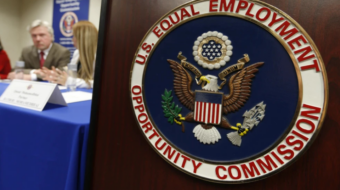(Read Part 1 here.)
The turmoil in financial markets and the bailout to the tune of $700 billion has turned the public eye and wrath on Wall Street and Washington. While millions are aware of the triggering causes, ranging from predatory lending to deregulation to insatiable greed, what isn’t so obvious is the longer-term process that brought our financial system and economy to the edge of the abyss.
I call this process financialization. According to economist Gerald Epstein, financialization is a process in which “financial motives, financial markets, financial actors, and financial institutions come to play an increasing role in the operation of domestic and international economies.” (“Financialization and the World Economy,” 2005, introduction)
It started in the 1970s
In its present form, financialization goes back to the mid-1970s. At that time U.S. capitalism was beset by seemingly intractable and contradictory problems — high inflation and unemployment, declining confidence in the dollar, faltering competitiveness, slow growth, and a falling profit rate.
Faced with this unraveling of the economy and weakening of the position of U.S. imperialism on a global level, then-chairman of the Federal Reserve Paul Volcker stepped into the breech and pushed up interest rates to record levels. This wrung inflation out of the economy, but it also sent unemployment rates to the highest level since the Great Depression, forced the closing of scores of manufacturing plants and many more family farms, brought incredible hardship to the working class and especially the African American, Latino and other communities, and negatively impacted the global economy, particularly the developing countries in Asia, Africa and Latin America.
At the same time, the spike in interest rates to record levels redirected domestic and foreign capital abruptly and massively into financial channels where returns to capital were now extremely high. Volcker, as an experienced banker, knew that the capitalists’ problem wasn’t too little money capital, but rather too few opportunities to profitably invest a surplus of capital — a crisis of over-accumulation of capital.
Moreover, once in financial channels, money capital remained there, but not idly. Driven by its own nature to constantly expand and reinforced by competitive pressures of competing capitals (grow or die) in a permissive regulatory environment, the financial agents of capital (banks, investment houses, hedge funds, private equity firms and so on) raced at breakneck speed into a massive buying and selling and borrowing and spending spree for the next three decades — all of which led to an explosion of the financial sector in terms of employment, transactions, instruments, players and profits. In other words, financialization proceeded at a feverish pace and with a broad sweep.
Capital that produces little destroys much
Unlike productive capital that reproduces and expands itself by extracting surplus value and profits from labor power in the production process, money capital is much more footloose and impatient. Its time frame is short term. It travels the globe in an instant thanks to computerization and the web. Sinking itself into longer-term investments in plants, equipment and new technologies that create jobs and grow the economy is something that financial capital does, but this is not its favorite cup of tea, especially in recent years. In fact, money capital is as likely to destroy plants and equipment as invest in them — witness our Rust Belt and the structural adjustment policies imposed on developing and former socialist countries.
Where possible, money capital hides in the shadows beyond the eyes of weakened regulatory authorities. Like a good entrepreneur, it invents new “products” (options, swaps, futures, derivatives), but highly risky ones, and then sells, buys and profits from them. When turmoil seizes the financial markets as is happening now, money capital cashes out and runs to safety until the storm blows over. In the event that it doesn’t reach a safe haven and absorbs huge losses, it is relieved in the knowledge that the federal government and Federal Reserve stand ready to bail out massive failures of big financial institutions, as we are seeing.
The lubricant of financialization is the production and reproduction of staggering amounts of debt — corporate, consumer and government. Debt is as old as capitalism, but what is different in this era of financialization is that the production of debt, speculative excesses and bubbles are now essential to the functioning of U.S. capitalism.
A two-edged sword
As it gained strength and scope in the late 1980s and ’90s, financialization grew to the point where it became the main determinant shaping the contours, structure, interrelations and evolution of the national and world economy. While financialization was an outgrowth of the systemic weaknesses and contradictions of U.S. capitalism, it was also the leading edge of a neoliberal model of capital accumulation and governance, designed to restore U.S. capitalism’s momentum, profitability and dominant position in domestic and world affairs.
But as we are painfully learning, financialization is a two-edged sword, not all peaches and cream. Indeed, its very successes opened up new fault lines in the U.S. and global economy, making it, as we so graphically see, unsustainable.
While it stimulated the domestic and global economy, it also left our nation with an astronomical pileup of household, government and corporate debt which can’t be unwound overnight.
While it gave an impulse to economic growth, it also introduced enormous instability into the arteries of the U.S. and world economy, evidenced by the frequent financial contagions at home and globally over the past two decades.
While it prolonged the upward cyclical movements of capitalism, it has also set the stage for a hard economic landing and a much deeper crisis eventually, which is what we are experiencing now.
While it created wealth on a substantial scale, it also successfully engineered the biggest transfer of wealth in our nation’s history from wealth creators — the world’s working people — to wealth appropriators, the upper crust of U.S. finance capital.
While attracting mobile capital to our financial markets, it also has made us dependent on the willingness of foreign investors to absorb massive amounts of debt, something that they are increasingly less inclined to do, as the dollar drops in value on international currency markets and our markets collapse.
While the debt-driven purchasing power of American consumers bolstered global demand, it also tied the world’s economy to our heavily financialized, indebted, and unstable economy. New model of economic governance needed
And yet, despite this incredible wreckage, this almost incomprehensible corruption, this reckless speculation, these merchants of plunder, debt and hardship are still attempting to resolve this financial crisis in a way that continues to leave them in charge of the main levers of power and their wealth intact.
This is not “socialism,” as we hear from the extreme right. It is parasitic state monopoly-finance capitalism. Or, in more colorful language, out-of-control cowboy/casino capitalism.
The American people and their friends in Congress are faced with a first-class challenge. In the near term, some immediate measures must be taken to restore the orderly functioning of financial markets, to recharge the economy, and, above all, to improve living conditions for the American people.
In the longer term, what is required is a new model of economic governance at the state and corporate level. By that I mean a reconfiguring of the role and functions of government and corporations so that they favor working people, the racially and nationally oppressed, women, youth and other social groupings. This will not only require the election of Democratic Party nominee Barack Obama, but also a sustained struggle by a labor-led people’s coalition in concert with its allies in the nation’s capital on what will be new political terrain.
Recent events have undermined the legitimacy of the neoliberal model of governance and accumulation so eagerly embraced by the Bush administration and Republicans in Congress. (No wonder they say they don’t want to play the “blame game.”)
But a substitute is not in place. Instead, we have a political vacuum into which various contending forces will try to impose their model of governance as we go forward.
In my view, such a model should draw from the New Deal experience, but in the end it has to be shaped in the first place by today’s conditions and requirements for political and economic advance for our nation’s working people and oppressed people, broadly defined. It won’t be socialist, but it would challenge the power and practices of the agents of capitalism, insist on peace and equality, consider public takeover of our energy and financial complex, and de-militarize and green our economy and society.
Depression conditions prompted Franklin Delano Roosevelt and his advisers — albeit with a mighty assist from a powerful all-people’s coalition led by the industrial unions and the multiracial working class — to reconfigure the role and functions of the state to the advantage of the ordinary people. We should draw inspiration and energy from this and set a similar course










